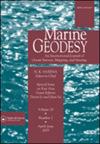用海洋GNSS测量、海面模型和芬兰湾额外重力观测验证大地水准面模型
IF 1.4
4区 地球科学
Q2 GEOCHEMISTRY & GEOPHYSICS
引用次数: 4
摘要
摘要传统上,大地水准面模型仅使用陆地上的全球导航卫星系统水准基准进行验证。由于无法在海上建立此类基准,因此必须以不同的方式评估大地水准面模型的海洋区域。在这项研究中,我们提出了一项海洋GNSS/重力活动,通过GNSS测量和海面模型在海域验证了现有的大地水准面模型。此外,还验证了使用新收集的海洋重力数据计算的新大地水准面模型。该活动由海洋地质研究双体船Geomari(由芬兰地质调查局运营)执行,该船于2018年初夏在芬兰湾芬兰领海东部来回航行。根据全球导航卫星系统和海面数据,我们能够以几厘米的精度获得海域的大地水准面高度。当将GNSS导出的大地水准面高度与大地水准面模型的大地水准面的高度进行比较时,在活动区的最东部和最南部可以看到各个模型之间的差异。新的重力数据使大地水准面模型高度变化了15 cm的稀疏/不存在的重力数据区域。本文章由计算机程序翻译,如有差异,请以英文原文为准。
Validating Geoid Models with Marine GNSS Measurements, Sea Surface Models, and Additional Gravity Observations in the Gulf of Finland
Abstract Traditionally, geoid models have been validated using GNSS-levelling benchmarks on land only. As such benchmarks cannot be established offshore, marine areas of geoid models must be evaluated in a different way. In this research, we present a marine GNSS/gravity campaign where existing geoid models were validated at sea areas by GNSS measurements in combination with sea surface models. Additionally, a new geoid model, calculated using the newly collected marine gravity data, was validated. The campaign was carried out with the marine geology research catamaran Geomari (operated by the Geological Survey of Finland), which sailed back and forth the eastern part of the Finnish territorial waters of the Gulf of Finland during the early summer of 2018. From the GNSS and sea surface data we were able to obtain geoid heights at sea areas with an accuracy of a few centimetres. When the GNSS derived geoid heights are compared with geoid heights from the geoid models differences between the respective models are seen in the most eastern and southern parts of the campaign area. The new gravity data changed the geoid model heights by up to 15 cm in areas of sparse/non-existing gravity data.
求助全文
通过发布文献求助,成功后即可免费获取论文全文。
去求助
来源期刊

Marine Geodesy
地学-地球化学与地球物理
CiteScore
4.10
自引率
6.20%
发文量
27
审稿时长
>12 weeks
期刊介绍:
The aim of Marine Geodesy is to stimulate progress in ocean surveys, mapping, and remote sensing by promoting problem-oriented research in the marine and coastal environment.
The journal will consider articles on the following topics:
topography and mapping;
satellite altimetry;
bathymetry;
positioning;
precise navigation;
boundary demarcation and determination;
tsunamis;
plate/tectonics;
geoid determination;
hydrographic and oceanographic observations;
acoustics and space instrumentation;
ground truth;
system calibration and validation;
geographic information systems.
 求助内容:
求助内容: 应助结果提醒方式:
应助结果提醒方式:


